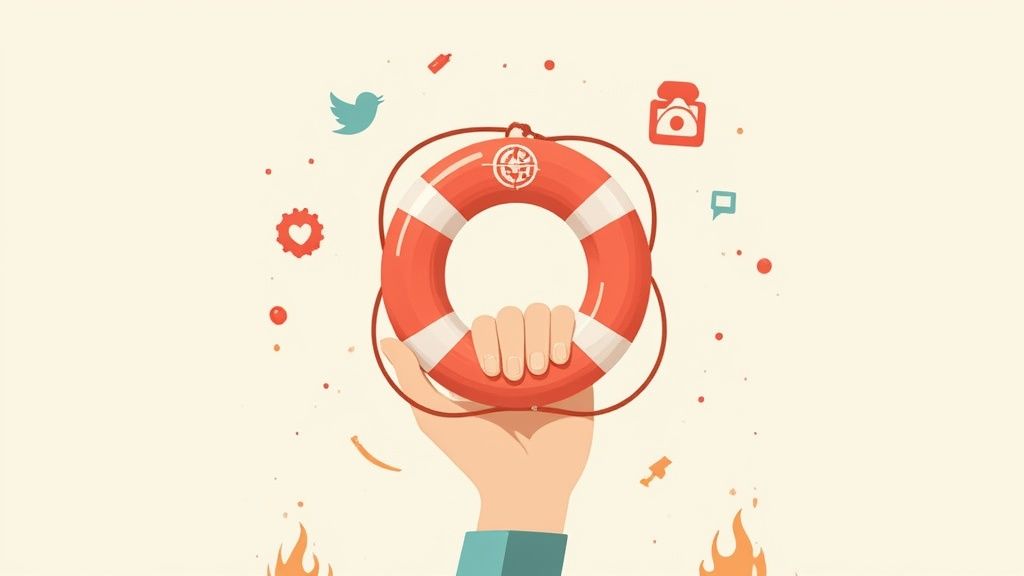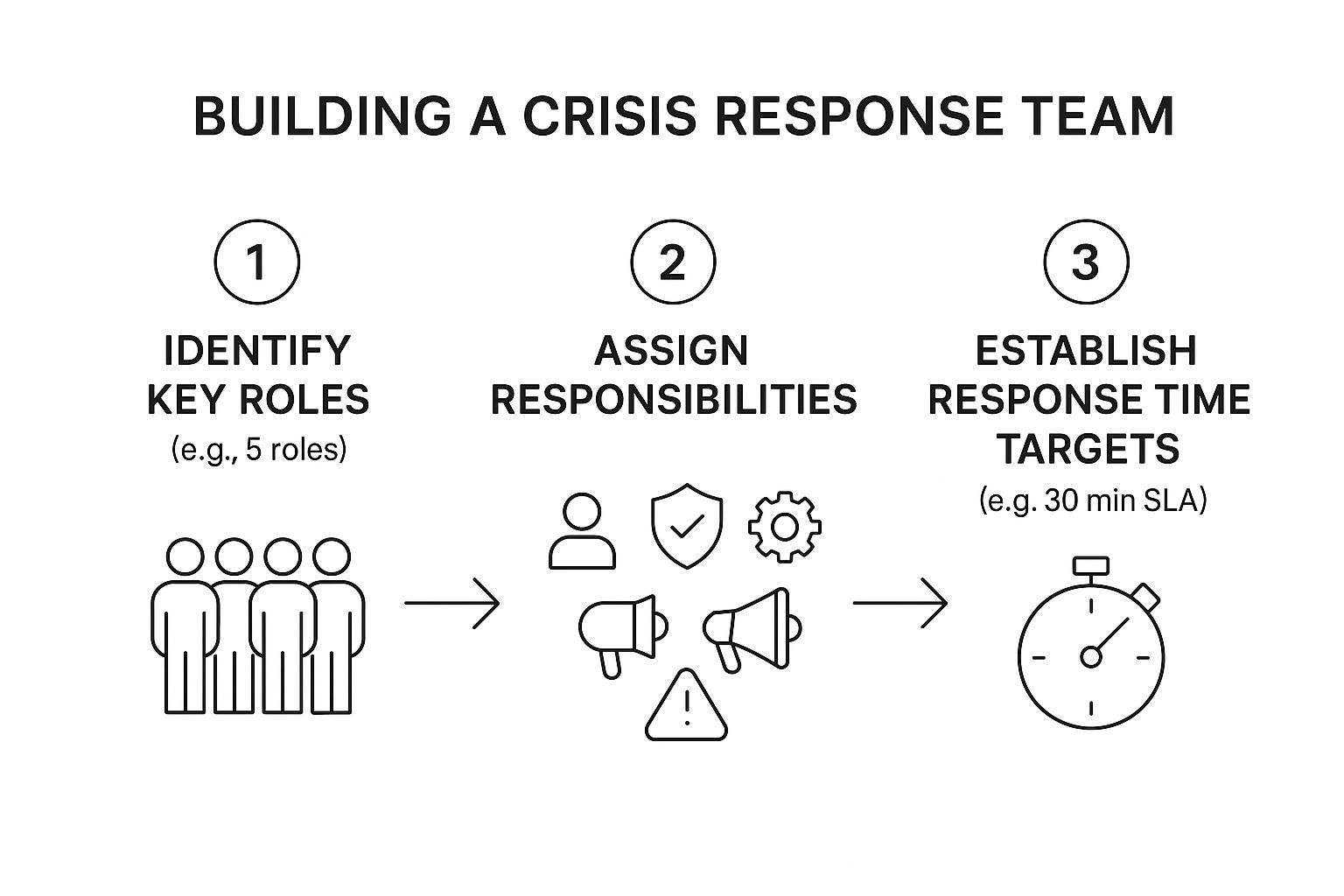Social Media Crisis Management Guide for Brands

Social media crisis management is the game plan for dealing with brand-threatening issues that pop up on social platforms. It’s about being prepared to identify and shut down problems before they do real damage to your reputation. This means having a clear plan, pre-approved messages, and a dedicated team ready to jump in with speed and empathy. It’s your brand’s essential survival kit in a world where bad news travels at the speed of light.
Why Social Media Crisis Management Matters Now More Than Ever
Picture your brand’s online presence as a bustling town square. It’s full of energy and opportunity, but it’s also completely unpredictable. One wrong comment, one slip-up with a product, and you can have a full-blown riot on your hands. This is precisely why social media crisis management has shifted from a “nice-to-have” PR task to a core business need. It’s not just damage control; it’s your pre-built emergency response system.
With over five billion people on social media, information—and misinformation—spreads like wildfire. A single customer complaint in one city can become a global headline before your team has even had their morning coffee. Without a solid plan, companies are left scrambling, often making things worse with slow, clumsy, or tone-deaf replies.
Before we dive deeper, it's crucial to distinguish between a proactive and a reactive stance. Many brands fall into the trap of only acting after a crisis has already exploded. A proactive approach, however, is about building the systems and monitoring to see the smoke before the fire starts.
Reactive Vs Proactive Crisis Management Approaches
| Characteristic | Reactive Approach | Proactive Approach |
|---|---|---|
| Timing | Responding after an issue has escalated and gone public. | Monitoring for potential threats and addressing them early. |
| Mindset | "Damage control." Focus is on minimizing negative impact. | "Prevention and preparedness." Focus is on building resilience. |
| Actions | Scrambling for information, drafting statements under pressure. | Having pre-approved templates, clear roles, and escalation plans. |
| Tools | Basic social media notifications and manual searches. | Advanced social listening tools to detect sentiment shifts. |
| Outcome | Often leads to reputational harm, loss of trust, and higher costs. | Can de-escalate issues, strengthen trust, and protect the bottom line. |
Ultimately, a proactive strategy doesn't just manage a crisis better—it can often prevent one from ever happening.
Protecting Brand Trust and Reputation
Trust is the most valuable currency your business has, and online, it's incredibly fragile. When you handle a crisis well, you show accountability and transparency, which can sometimes even make customers more loyal. But if you fumble it, you can destroy years of hard-earned brand equity in a matter of hours. A proactive plan ensures you always communicate with a consistent, human voice that reassures your audience and protects the reputation you’ve worked so hard to build.
A strong social media crisis management plan spells out clear escalation tiers, pre-approved messaging, and AI-powered social listening to catch warning signs early. It enables cross-functional teams to respond with the speed and empathy that modern consumers expect.
Safeguarding Financial Stability
The fallout from a social media crisis goes way beyond hurt feelings and negative comments. It can hit your bottom line hard through customer boycotts, a nosedive in sales, and even a drop in your stock price. Investing time and resources into getting prepared is always cheaper than trying to rebuild a shattered reputation from the ground up.
This forward-thinking approach is driving huge growth in the market. The social media crisis management services space was valued at over USD 1.88 billion in 2023 and is on a steep upward climb. This boom shows a clear shift away from reactive fixes toward proactive strategies built on real-time monitoring.
For a deeper look into practical strategies, you can explore these expert social media crisis management tactics. A key part of being proactive is watching for unusual activity in your data, and you can learn about the most important social media metrics to track in our detailed guide. At the end of the day, a solid plan makes your brand more resilient, turning a potential disaster into a managed hiccup.
Building Your Social media Crisis Management Playbook
A crisis doesn’t wait for you to figure things out. When the fire starts online, every second you spend scrambling for answers is a second that lets misinformation and negativity spread like wildfire. A social media crisis management playbook is your pre-written script for that chaos—a detailed action plan that swaps panic for a structured, decisive response.
Think of it like a fire drill. You don't start looking for the exits when you see smoke; you practice the escape route beforehand so your actions are almost instinctual. This playbook is your brand's digital emergency plan, making sure everyone knows their role, what to say, and exactly how to act when the alarm bells start ringing.

Assembling Your Crisis Response Team
First things first: you need to know who’s on the front lines. A crisis can't be wrangled by a single person or department. It demands a cross-functional team that can make smart, informed decisions on the fly. Figuring out who's in charge after a crisis hits is a guaranteed recipe for disaster.
Assign clear roles and responsibilities so there’s zero confusion when the pressure is on. Your team should operate like a pit crew in a race—every member has a specific job, and they execute it with speed and precision.
Here are the essential roles you need to fill:
- The Commander: This is your decision-maker, usually a senior leader from communications, marketing, or even legal. They have the final say on the strategy and give the green light for any public statements.
- The Analyst: This person is glued to your social listening tools. Their job is to monitor the conversation, track sentiment, and feed real-time intelligence back to the team.
- The Communicator: This is your wordsmith. They're responsible for drafting all public-facing messages, from the initial holding statement to detailed updates and apologies.
- The Community Manager: This team member is in the trenches, directly engaging with your audience. They’re the ones responding to comments and DMs, armed with pre-approved messaging.
- The Legal Counsel: Legal oversight is completely non-negotiable. This person reviews every communication to make sure it's accurate and doesn't create even more liability for the company.
Establishing a Communication Approval Protocol
Speed is everything in a social media crisis, but not at the expense of accuracy. A rushed, unvetted statement can be like pouring gasoline on the fire. You need a streamlined approval process that balances being fast with being careful.
This shouldn't be a bureaucratic nightmare. Create a simple, clear flowchart showing who needs to approve what, and in what order. For minor flare-ups, a comms lead might have the final say. For a full-blown crisis, that chain might go all the way up to the CEO.
The goal here is to eliminate bottlenecks. During a crisis, you don't have time for a critical message to sit in someone's inbox for hours. Define your approval workflow now, so it’s second nature when it counts.
This workflow is really just an extension of your company’s voice. To keep crisis communications consistent with your established tone, you need a solid foundation. If your team struggles with consistency, having a brand style guide template can provide the structure you need to maintain a unified voice, even under extreme pressure.
Setting Up Your Early Warning System
You can’t respond to a crisis you don’t see coming. Modern social listening tools are your digital smoke detectors, built to alert you to potential problems before they become five-alarm infernos. These platforms do more than just track keywords; they analyze sentiment, spot unusual spikes in mentions, and identify the influential accounts driving the narrative.
Set up your tools to monitor for a few key things:
- Brand Mentions: Keep tabs on every mention of your company, products, and key executives.
- Negative Sentiment Spikes: Create automated alerts for any sudden, significant drop in sentiment. A 20% dip in an hour is a massive red flag.
- Competitor Crises: Watch the issues affecting your competitors. You can learn a lot from their mistakes and anticipate similar weak spots for your own brand.
- Industry Keywords: Pay attention to conversations around sensitive topics relevant to your industry.
A solid crisis plan should be a seamless part of your entire social media operation, not some dusty document you pull out once a year. It all begins with creating a comprehensive social media strategy.
Preparing Response Templates and Holding Statements
When a crisis hits, you won’t have time to workshop the perfect message from scratch. This is where pre-written, pre-approved templates become an absolute game-changer. These aren't meant to be robotic, copy-and-paste replies, but flexible frameworks you can quickly adapt to the specific situation.
Your template library should include:
- Holding Statements: A short, empathetic message you can post immediately while you gather the facts. For example: "We're aware of the situation and are looking into it urgently. We take this very seriously and will share more information as soon as we have it."
- Apology Templates: Frameworks for taking accountability, showing sincere regret, and explaining what you're doing to fix things.
- Fact-Correction Messages: Simple, polite templates to correct misinformation that’s spreading online.
- Internal Communication Updates: Drafts to keep your own employees in the loop and aligned with the public narrative.
By building this playbook, you turn a scary, abstract threat into a series of clear, manageable steps. It’s the ultimate way to prepare for protecting your brand's reputation in a wild and unpredictable digital world.
Executing an Effective Three-Phase Crisis Response
When a social media crisis erupts, you’re not working with a calendar—you’re working with a stopwatch. Panic is the enemy. A disorganized scramble can take a small, contained fire and turn it into a full-blown catastrophe. The key isn't a single magic-bullet response, but a structured, methodical approach designed to defuse the tension, regain control of the story, and start rebuilding trust.
Think of it like a fire department's playbook: assess, contain, and then tackle the root cause. This deliberate process stops you from just reacting and puts you in a position to strategically manage the situation from beginning to end. We can break this down into three core phases: Acknowledgment, Action, and Resolution.
Each one has a distinct job to do and demands a different set of tactics. Getting them right is the foundation of turning a crisis around.
Phase 1: Acknowledgment
This is your first move, and it's arguably the most critical. The Acknowledgment phase is simply your first public signal that you're aware of the problem. Your best friends here are speed and empathy. When a company goes silent, people immediately assume the worst and start filling in the blanks themselves. That's how misinformation spreads like wildfire.
A quick holding statement confirms you're engaged and taking it seriously. It’s not meant to have all the answers—in fact, trying to explain everything at this stage is a mistake. The goal is to hit the pause button on the negativity while your team gets its facts straight.
A simple, human message is all you need:
- "We're aware of the situation and are looking into it with the utmost urgency."
- "We've seen your concerns and want you to know we're taking this very seriously."
- "An issue has been brought to our attention. Our team is investigating, and we will share an update as soon as we have more information."
This buys you precious time and shows you’re committed to being transparent from the get-go. It’s a small gesture that can keep a spark from becoming an inferno.
Phase 2: Action
Okay, you've acknowledged the issue. Now the spotlight shifts to Action. This is where you prove you’re doing more than just "looking into it." Your audience needs to see tangible steps being taken to fix whatever went wrong. This is where transparency really shines.
Keep people in the loop with clear, consistent updates. If a product is faulty, show the fix in progress. If an employee made an insensitive comment, explain the new internal training you're rolling out. This is your chance to back up your words with real, concrete actions.
Being transparent about your actions helps shift the narrative from what went wrong to what you're doing to make it right. This builds credibility and shows your audience you are genuinely committed to resolving the problem.
Having the right people in place is everything. A well-oiled crisis team can execute these phases seamlessly, moving from acknowledgment to action without missing a beat.

As you can see, a successful response relies on having a pre-defined team and clear goals, which is what allows you to move quickly and decisively when the pressure is on.
Phase 3: Resolution
Finally, it's time for the Resolution phase. This is all about closing the loop. You've acknowledged the problem and showed your work; now you need to communicate the final outcome and, if necessary, make amends. This is absolutely vital for rebuilding trust and moving on.
Announce the solution clearly. Explain what happened, why it happened, and what you’ve done to make sure it never happens again. A sincere apology is often a huge part of this, but it only feels authentic when it’s backed up by the genuine action you took in the previous phase.
Don't think this is a once-in-a-blue-moon event. Statistics show that 69% of businesses will face a social media crisis at least once every five years. The stakes are incredibly high, as 43% of consumers say they'll boycott a brand after a single poor crisis response. Empathetic, timely communication isn't just nice—it's essential. You can discover more insights about crisis communication effectiveness and its direct line to customer loyalty.
By navigating these three phases well, you don't just survive a crisis. You can actually come out the other side with a stronger, more resilient brand reputation.
Lessons from Real-World Social Media Crises
Theory is great, but nothing teaches you about social media crisis management like seeing it unfold in the wild. High-stakes meltdowns show you what works—and what goes down in flames. By looking at how real brands handled the heat, we can turn abstract ideas into hard-earned lessons.

Think of these case studies as both blueprints and cautionary tales. They're proof that a smart strategy can save your skin, while a clumsy response can wreck customer trust and hit you right in the wallet.
The Good: A Masterclass in Ownership and Speed
Some brands handle turbulence so well they actually come out looking stronger. Their secret? Accountability, transparency, and a solid grasp of what their audience actually wants to hear.
One of the best examples of crisis management came from the last place you'd expect: a fast-food joint. Back in 2018, KFC UK hit a logistical wall when a new delivery partner left hundreds of its restaurants completely out of chicken. The public backlash was instant, with #KFCCrisis trending on Twitter almost immediately.
Instead of hiding or pointing fingers, KFC leaned right into the chaos. They took out full-page newspaper ads showing an empty bucket rearranged to spell "FCK," followed by a refreshingly honest and funny apology. It was perfectly in sync with their brand voice—bold, a bit cheeky, and totally human.
By owning the mistake with humor and transparency, KFC didn't just mitigate the damage; they turned a potential brand disaster into a PR victory that generated positive sentiment and reinforced customer loyalty.
This moment perfectly captures the power of a quick, authentic, and on-brand response. It’s a reminder that you don’t always have to be serious to be effective. Sometimes, just acknowledging the absurdity of a situation with a human touch is all you need.
The Bad: Deleting Comments and Evading Responsibility
On the flip side, you have brands that crack under pressure and turn a small fire into an inferno. These blunders usually come from a place of defensiveness, a lack of transparency, or just not getting how social media works.
The classic mistakes are almost a checklist of what not to do:
- Deleting Negative Comments: This is like sticking your fingers in your ears and yelling, "I can't hear you!" It tells your audience you're trying to hide something, which only makes them angrier.
- Issuing Hollow Apologies: Phrases like "we're sorry if you were offended" aren't apologies at all. They shift the blame to the customer, adding insult to injury.
- Responding Too Slowly: On social media, silence looks like guilt. Waiting too long lets rumors and negativity spiral out of control, making it nearly impossible to steer the conversation back in your favor.
The Decisive: A Case for Proactive Communication
When things go wrong, speed, transparency, and authenticity are your best friends. The Target data breach is a textbook case. When millions of customer credit card details were exposed, the company moved with incredible speed.
Within hours, the CEO was on social media with video messages, offering a clear apology and explaining exactly what they were doing to help. They offered free identity protection and set up dedicated support channels. It was a masterclass in a customer-first response. You can read more about crisis communication strategies that build trust on odwyerpr.com.
Ultimately, these real-world examples drive home one crucial point. A crisis doesn't have to define your brand. Your response to it will.
Essential Tools for Your Crisis Management Toolkit
Let's be blunt: you can't manage a modern social media crisis without the right technology. When things go sideways, trying to track everything by hand while coordinating a response through scattered emails is a guaranteed recipe for failure. A smart team leans on a solid tech stack to listen in on the conversation, manage the response, and get control of the narrative.
Think of these tools like a firefighter's gear. You don't start hunting for a hose and an axe when the building is already engulfed in flames. You have them ready to go. Having your crisis toolkit set up before you need it isn't just a good idea—it's a non-negotiable part of being prepared.
Social Listening and Monitoring Tools
Your social listening platform is your digital smoke detector. It’s the early warning system that catches the first whispers of trouble before they explode into a full-blown inferno. These tools do a lot more than just track brand mentions; they analyze sentiment, spot weird spikes in volume, and pinpoint the influential voices steering the conversation.
Here’s what you should be looking for:
- Real-Time Alerts: You need automated pings for sudden drops in sentiment or a surge in negative keywords. A 20% dip in positive sentiment within an hour is a massive red flag that demands immediate attention.
- Sentiment Analysis: This is how you quickly gauge the public mood. It helps you tell the difference between a few minor grumbles and a genuine wave of anger, giving you the context to prioritize your response.
- Keyword Tracking: Don't just watch your brand name. Monitor your campaign hashtags, executive names, and even common industry pain points. This gives you the full picture.
Platforms like Brandwatch or Talkwalker are masters at this. They give you the situational awareness needed to get ahead of a crisis instead of just reacting to it.
Communication and Collaboration Platforms
While listening tools spot the fire, your communication platforms are the command center where your team coordinates the fight. During a crisis, information has to flow seamlessly between PR, legal, marketing, and the C-suite. Clunky email chains and messy group texts just won’t fly when every second counts.
A centralized communication hub ensures that every member of the crisis response team is working from the same script. This prevents conflicting messages, streamlines the approval process, and allows for a swift, unified public response.
Tools like Slack or Asana are built for this. You can spin up a dedicated, private channel just for the crisis. This is where the team shares real-time updates, drafts statements, and gets the green light from legal or leadership without any delay. It’s a single space that cuts through the confusion and keeps everyone aligned under pressure.
Media Monitoring Services
A social media crisis rarely stays on social media. A viral tweet can quickly morph into a headline on major news sites, and a TikTok can easily end up on the evening news. This is where media monitoring services like Cision or Meltwater become invaluable.
These platforms scan way beyond social channels, keeping an eye on online news articles, blogs, forums, and even broadcast media for mentions of your brand. They help you grasp the full scope of the crisis and see how it's being framed by journalists and the wider media. This bigger-picture view is absolutely vital for crafting a complete response that tackles the story on all fronts.
Top Social Media Crisis Management Tools
Choosing the right tools can feel overwhelming, but thinking about them in terms of their core function helps simplify things. Here’s a quick breakdown of the essential tool categories and what they bring to the table during a crisis.
| Tool Category | Example Tools | Key Crisis Feature |
|---|---|---|
| Social Listening | Brandwatch, Talkwalker, Sprinklr | Real-time alerts for keyword spikes and sentiment shifts |
| Team Collaboration | Slack, Microsoft Teams, Asana | Dedicated, private channels for instant communication |
| Media Monitoring | Cision, Meltwater, Mention | Tracking brand mentions across news, blogs, and broadcast |
| Response & Publishing | Sprout Social, Hootsuite | Approval workflows and comment moderation |
This combination of tools ensures you have eyes on the conversation, a command center for your team, and a way to track the story as it spreads, giving you a comprehensive setup for managing any crisis that comes your way.
For brands focused on crafting consistent messaging during a crisis, exploring the latest AI content creation tools can be a game-changer, helping produce aligned communications at speed. By pulling these three types of tools together, you're not just buying software; you're building a powerful tech stack that gives your team the confidence to handle whatever comes their way.
Turning a Crisis Into a Brand-Building Opportunity
When a social media crisis hits, it feels like a fire you just need to put out. Survival mode kicks in. But what if there’s more to it than just damage control? While we’ve been focused on the nuts and bolts of preparation and response, the real measure of your brand is what happens after the storm passes.
A well-handled crisis can do more than just stop the bleeding—it can become a powerful moment that actually builds your brand.

Think about it. When you respond with speed, transparency, and genuine empathy, you're doing something a multi-million dollar ad campaign can only dream of: you’re proving what your company truly stands for, right out in the open. It’s your chance to show you’re accountable when things go wrong, and that’s how you turn critics into fans and solidify customer loyalty for the long haul.
It's not just a nice idea, either. Research shows that 72% of consumers will stick with a brand that owns up to a crisis and handles it with sincerity. It’s a direct investment in trust.
Your First Steps Toward Preparedness
Instead of living in fear of a crisis, it's time to get ready to master one. Great social media crisis management is all about proactive moves, not panicked reactions.
Here’s a simple checklist to get you started on the path from being vulnerable to being resilient:
- Assemble Your Team: Don't wait for the fire alarm. Designate your core crisis response team today. Outline everyone’s role so there’s zero confusion when the pressure is on.
- Activate Listening Tools: You can’t fight a fire you can’t see. Set up your social listening tools to flag spikes in negative sentiment or a sudden explosion in mentions. This is your early warning system.
- Draft a Holding Statement: Write just one pre-approved, empathetic holding statement. Seriously. Having this in your back pocket buys you precious minutes and stops the team from scrambling and improvising under stress.
Got Questions About Crisis Management? We’ve Got Answers.
Even with the most detailed crisis plan in your back pocket, questions always pop up—usually when the pressure is on. Getting your team aligned on the answers before you need them is the key to moving forward with confidence. Let's tackle some of the most common questions brands have when things go sideways on social media.
One of the biggest points of confusion is simply knowing when you're dealing with a real crisis versus just another Tuesday. A few grumpy comments or a one-off customer complaint? That's business as usual. A crisis is a whole different beast—it's an event that poses a genuine threat to your reputation, your bottom line, or your ability to operate, and it’s usually spreading like wildfire.
What’s the Very First Thing We Should Do?
When you first suspect a crisis is brewing, the immediate first step is to get your response team together internally. Before a single word is typed publicly, your core group needs to huddle up, get the basic facts on the table, and use your social listening tools to see just how bad it is.
This initial huddle is where you make your most important call: Is this a low-level issue we just need to watch, or a full-blown, code-red event that needs an immediate public response? That decision shapes every single move that follows.
The goal in the first 30 minutes isn’t to solve the entire problem. It’s to understand its size and speed. So many brands trip up by rushing out a half-baked response, turning a small fire into an inferno.
How Do We Know if It’s Really a Crisis?
The line between routine negativity and a true social media crisis comes down to two things: impact and velocity. While every company has its own pain threshold, a real crisis usually checks several of these boxes.
- It's Going Viral: The issue isn't just simmering; it’s exploding across platforms, often fueled by big accounts or trending hashtags.
- It's a Reputational Threat: The conversation is toxic enough to cause real, long-term damage to the trust you've built with your audience.
- The Media Is Calling: News outlets or major industry blogs have picked up the story. It has officially escaped the social media bubble.
- It's Hitting Operations: The online chatter is having real-world consequences, like customers calling for a boycott or services being disrupted.
How Do We Know if Our Response Is Working?
Measuring the success of your social media crisis management isn't just about making the noise stop. True success is about recovery and rebuilding trust, and you can track it with a few key indicators.
First, keep a close eye on sentiment analysis. A good response will slowly but surely turn the tide from overwhelmingly negative mentions back toward a neutral or even positive tone. You also need to watch mention volume. After that initial spike, you want to see the number of conversations about the crisis die down and return to your baseline.
Finally, look at the engagement on your official statements. Are people accepting your message, or are they tearing it apart? A crisis handled with transparency and care can, surprisingly, end up making your brand stronger once the dust settles.